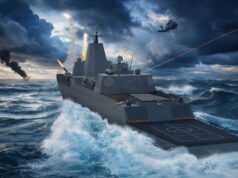HMS Queen Elizabeth will sail for rotary wing trials at sea shortly, where she will undergo deck trials with Royal Navy Merlin helicopters.
The next phase will be critical to establishing carrier strike capability. The MoD must bring together the carriers, Lightning jets, and Crowsnest with trained crews and supporting infrastructure, logistics, communications and surveillance capabilities.
The First of Class Rotary Wing trials will take place in the Western Atlantic. The work will determine the sea states and wind limits Merlin helicopters can operate in.
Lieutenant Commander Jim Cobbett said:
“These Sea Acceptance Trials (Air) or ‘SAT (Air)’ has proved the ship’s aircraft services are ready for action with a live helicopter and that everything functions correctly. Introducing the Ship to aviation and aviation to the Ship is all part of the learning structure we are going through.
We are taking it slowly at first before we embark whole squadrons of rotary and fixed wing aircraft.”
More immediately, the supercarrier will undergo two weeks of Flag Officer Sea Training assessment to determine whether her crew are ready for the more intensive training. Flag Officer Sea Training (FOST) provides Operational Sea Training for all surface ships, submarines and Royal Fleet Auxiliaries of the Royal Navy by a dedicated team of experts, led by Flag Officer Sea Training.
In Autumn 2018, HMS Queen Elizabeth will sail for the United States where flight trials with the F-35 will begin.
It is essential to test and operate all these elements together in preparation for Initial Operating Capability for Carrier Strike in 2020 followed by her first operational deployment in 2021. She will reach full operating capability for carrier strike in 2023.
For a detailed breakdown of when things will be happening with each ship and the aircraft squadrons involved, we suggest savetheroyalnavy.org and their ‘Carrier Strike Timeline‘.
The Key Numbers:
- The project to build HMS Queen Elizabeth and sister ship HMS Prince of Wales cost more than £6 billion.
- The aircraft carrier weighs 70,600 tonnes and has a top speed of 25 knots (this however has been exceeded frequently).
- Its flight deck is 280 metres long and 70 metres wide – enough space for three football pitches.
- The ship is the second in the Royal Navy to be named Queen Elizabeth.
- The ship will have a crew of around 700, increasing to 1,600 when a full complement of F-35 jets and Crowsnest helicopters are embarked.
- There are 364,000 metres of pipes inside the ship.
- Both HMS Queen Elizabeth and HMS Prince of Wales will keep 45 days’ worth of food in its stores.
- The entire Ship’s Company of 700 can be served a meal within 90 minutes – 45 minutes when at action station.
- Leaving the Rosyth dock was among the most difficult manoeuvres in the sea trials, with just 50cm between the bottom of the ship and the seabed in the port.













Didn’t we have a ‘What’s next for HIS Queen Elizibeth’ article last week?
yes, i think it is ongoing so it will keep coming back at each new stage with updated information
Fantastic pic!
It is a great picture. The Invincible class were capable vessels but they never had the QEC wow factor.
It would be nice if somebody at the RN woke up to the fact the ships are woefully under protected with only 3 Phalanx 1B gun systems per ship.
IN contrast the TCG Anadolu the amphibious assault ship been built for the Turkish navy will have 5 x Aselsan 25mm STOP, 2 x Phalanx CIWS, 1 x RAM as well as 6 F35B and 14 Helicopters and it will be a third of the weight of the British ACs
The QEC won’t just have 3 Phalanx….
I do think it needs more than a Phalanx though to cover such a large mass.
4 RAM launchers at least.